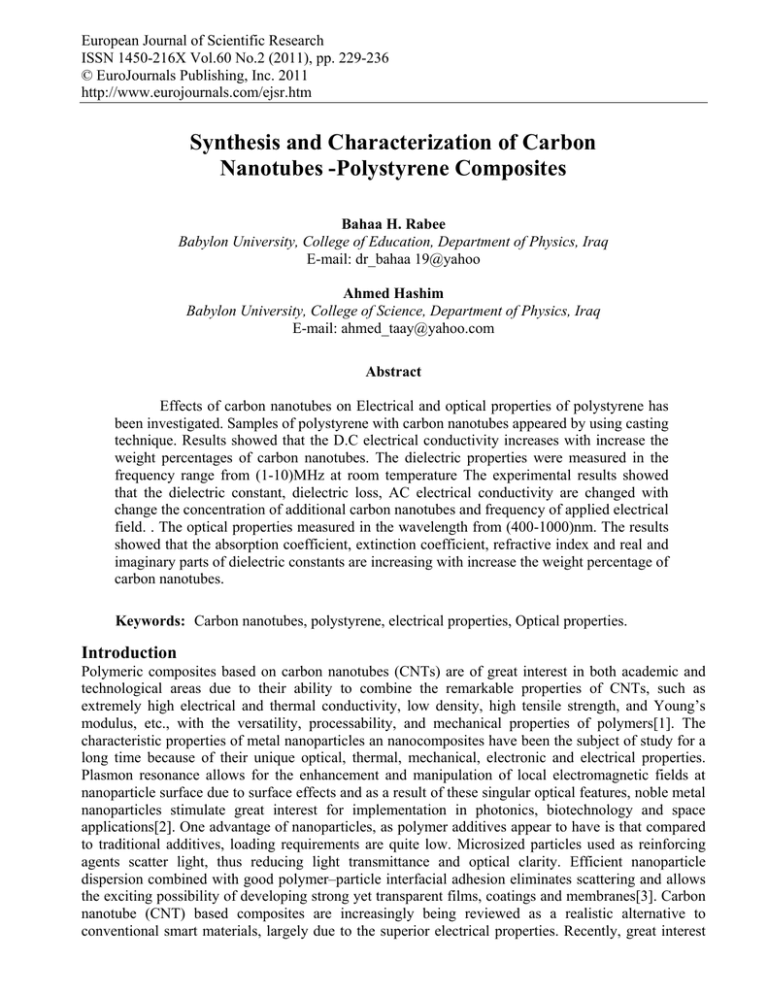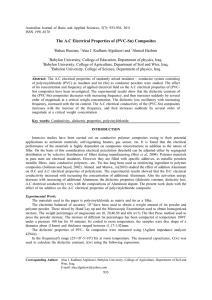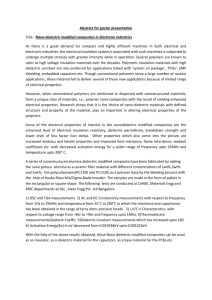
European Journal of Scientific Research
ISSN 1450-216X Vol.60 No.2 (2011), pp. 229-236
© EuroJournals Publishing, Inc. 2011
http://www.eurojournals.com/ejsr.htm
Synthesis and Characterization of Carbon
Nanotubes -Polystyrene Composites
Bahaa H. Rabee
Babylon University, College of Education, Department of Physics, Iraq
E-mail: dr_bahaa 19@yahoo
Ahmed Hashim
Babylon University, College of Science, Department of Physics, Iraq
E-mail: ahmed_taay@yahoo.com
Abstract
Effects of carbon nanotubes on Electrical and optical properties of polystyrene has
been investigated. Samples of polystyrene with carbon nanotubes appeared by using casting
technique. Results showed that the D.C electrical conductivity increases with increase the
weight percentages of carbon nanotubes. The dielectric properties were measured in the
frequency range from (1-10)MHz at room temperature The experimental results showed
that the dielectric constant, dielectric loss, AC electrical conductivity are changed with
change the concentration of additional carbon nanotubes and frequency of applied electrical
field. . The optical properties measured in the wavelength from (400-1000)nm. The results
showed that the absorption coefficient, extinction coefficient, refractive index and real and
imaginary parts of dielectric constants are increasing with increase the weight percentage of
carbon nanotubes.
Keywords: Carbon nanotubes, polystyrene, electrical properties, Optical properties.
Introduction
Polymeric composites based on carbon nanotubes (CNTs) are of great interest in both academic and
technological areas due to their ability to combine the remarkable properties of CNTs, such as
extremely high electrical and thermal conductivity, low density, high tensile strength, and Young’s
modulus, etc., with the versatility, processability, and mechanical properties of polymers[1]. The
characteristic properties of metal nanoparticles an nanocomposites have been the subject of study for a
long time because of their unique optical, thermal, mechanical, electronic and electrical properties.
Plasmon resonance allows for the enhancement and manipulation of local electromagnetic fields at
nanoparticle surface due to surface effects and as a result of these singular optical features, noble metal
nanoparticles stimulate great interest for implementation in photonics, biotechnology and space
applications[2]. One advantage of nanoparticles, as polymer additives appear to have is that compared
to traditional additives, loading requirements are quite low. Microsized particles used as reinforcing
agents scatter light, thus reducing light transmittance and optical clarity. Efficient nanoparticle
dispersion combined with good polymer–particle interfacial adhesion eliminates scattering and allows
the exciting possibility of developing strong yet transparent films, coatings and membranes[3]. Carbon
nanotube (CNT) based composites are increasingly being reviewed as a realistic alternative to
conventional smart materials, largely due to the superior electrical properties. Recently, great interest
Synthesis and Characterization of Carbon Nanotubes -Polystyrene Composites
230
has been generated in building highly sensitive strain sensors with these new composites[4].G.D.
Liang[5], in (2008) studied the electrical properties of the PS-Carbon nanofiber composites at the
percolation threshold. They found that both the electrical conductivity and the dielectric constant
increase at an additive concentration of 1.7 vol.%. They indicated that the electrical conductivity is
dependent on temperature at this concentration of the additive.
Experiment
The materials used in this study are polystyrene and carbon nanotubes. The weight percentages of
carbon nanotubes are (0,3,6 and 9)wt.%. The samples were prepared using casting technique thickness
ranged between (72-84)μm. The resistivity was measured at room temperature using Keithly
electrometer type (616C) .The volume electrical conductivity defined by :
1
v
(1)
L
RA
Where :
A = guard electrode effective area.
R = volume resistance (Ohm) .
L = average thickness of sample (cm) .
The dielectric properties of PS-CNTs composites were measured using (Agilent impedance
analyzer 6500B).
In the frequency(f) range (1-10) MHz at room temperature. The measured capacitance, C(w)
was used to calculate the dielectric constant ,έ(w) using the following expression:
(2)
έ(w) =C(w) d
o
A
Where d is sample thickness and A is surface area of the sample . whereas for dielectric loss
ε"(w):
ε"(w) = έ(w) × tanδ(w)
(3)
Where tanδ(w) is dissipation factor . The AC conductivity σac Can be calculated by the
following equation :
(4)
(w ) w "
ac
o
The transmission & absorption spectra of PS-CNTs composites have been recording in the
length range (400-1000) nm using UV-2400 PC spectrophotometer.
Results and Discussion
Figure(1) shows the variation of electrical conductivity of polystyrene composites with increasing
carbon nanotubes content. The general theory to explain the conduction mechanism of fibers or
particle-filled polymer composites is the "theory of conductive paths [6]. To obtain electrically
conductive composites the carbon nanotubes aggregates have to arrange themselves in continuous
paths where the conductive elements are either in direct contact or can move electrons via hopping or
tunneling mechanisms[7].
Figure 1: Variation of D.C electrical conductivity with Carbon nanotube wt. % concentration.
Conductivity(S/cm)
1.E-03
1.E-05
1.E-07
1.E-09
1.E-11
1.E-13
1.E-15
0
1
2
3
4
5
6
Con. corbon nanotube w t.%
7
8
9
231
Bahaa H. Rabee and Ahmed Hashim
Figure (2) show the variation of the dielectric constant of PS-CNTs composite with frequency
for different filler concentration.
Figure 2: Variation dielectric constant with frequency for (PS-CNTs) composite.
3
pure
3wt .%
dielectic constant
2.5
6wt .%
9wt .%
2
1.5
1
0.5
0
0.0E+00
2.0E+06
4.0E+06
6.0E+06
8.0E+06
1.0E+07
1.2E+07
F(Hz)
The dielectric constant decreases with increasing of frequency, this may be attributed to the
tendency of dipoles, the high value of dielectric constant at low frequency might be due to the
interfacial effect. At low carbon nanotubes concentration, the dielectric values are low, characteristics
of dielectric behaviour, and increasing the carbon nanotubes concentration caused an increase in the
average number of concentrations among the conductive particles. At high concentrations of carbon
nanotubes the dielectric constant is due to formation of a continuous network of carbon nanotubes
particles through the composite[8] .
Figure 3: Variation dielectric constant with carbon nanotube concentration for (PS-CNTs) composite.
14
dielectric constant
12
10
8
6
4
2
0
0
1
2
3
4
5
6
7
8
9
Con. of carbon nanotube wt.%
The variation of dielectric loss with frequency for (PS- CNTs) composites at different
concentration of dopants is as depicted in figure (4).
Figure 4: Variation dielectric loss with frequency for (PS-CNTs) composite.
pure
160
3 wt .%
6 wt .%
140
9 wt .%
dielectic loss
120
100
80
60
40
20
0
0.0E+00
2.0E+06
4.0E+06
6.0E+06
F(Hz)
8.0E+06
1.0E+07
1.2E+07
Synthesis and Characterization of Carbon Nanotubes -Polystyrene Composites
232
It is clear from the graph that dielectric loss decreases with increasing the frequency. The larger
value of dielectric loss at low frequency could be due to the mobile charges within the polymer
backbone. The higher value of dielectric loss for the higher concentration of dopant can be understood
in terms of electrical conductivity, which is associated with the dielectric loss as shown in figure
(5)[9,10].
Figure 5: Variation dielectric losss with carbon nanotube concentration for (PS-CNTs) composite.
16
14
dielectric loss
12
10
8
6
4
2
0
0
1
2
3
4
5
6
7
8
9
Con. of nanotube wt.%
The behaviour of A.C conductivity of PS- CNTs composite for various concentration of the
filler as a function of frequency at room temperature is show in figure(6).
Figure 6: Variation A.C. electrical conductivity with frequency for (PS-CNTs) composite.
pure
1.E-03
3wt.%
Conductivity(S/cm)
6wt.%
9wt.%
1.E-04
1.E-05
1.E-06
1.E-07
0.0E+00
2.0E+06
4.0E+06
6.0E+06
8.0E+06
1.0E+07
1.2E+07
F(Hz)
The A.C conductivity response to the applied field frequency at low and intermediate range is
flat, and at high frequency range there is a transition region where the response starts to bent
downward. The bending region is shifted towards the frequency value as the concentration of filler
increases. For specimens of high filler content the behaviour of A.C conductivity can be determined by
conductive pathways of conductive network which formed as a result of infinite clusters formation.
The flat response of A.C conductivity at these frequency ranges can be attributed to the fact that
electrons will not have trouble traveling over large distances within these infinite clusters before it just
hop to other clusters. This can be justified by the fact that most conductors give a flat response in the
same frequency ranges[11].At lower concentrations of the filler the A.C electrical conductivity of the
composite increases slightly; while at higher concentrations the conductivity increases sharply where
the composite becomes a conductive substance as shown in figure (7).
233
Bahaa H. Rabee and Ahmed Hashim
Figure 7: Variation A.C electrical conductivity with carbon nanotube concentration for (PS-CNTs) composite.
9.E-06
Conductiity(S/cm)
8.E-06
7.E-06
6.E-06
5.E-06
4.E-06
3.E-06
2.E-06
1.E-06
1.E-07
0
1
2
3
4
5
6
7
8
9
Con. of carbon nanotube wt.%
At high filler content, the a mount of the interconnecting networks is increased and the contact
resistance between the fibers is decreased, and hence a good electron conduction is achieved resulting
in transformation of the polymer insulator to a conductive polymer composite[12] .
The optical absorbance as a function of the wavelength of the incident light for PS-CNTs
composites of various filler contents is shown in figure (8) . The figure shows that the intensity of the
peak increased as a result of filler addition but no shift in the peak position, i.e. adding different
amounts of filler to pure polymer do not change the chemical structure of the material but new physical
mixture is formed.
Figure 8: Optical Absorbance for (PS-CNTs) composite with various wavelength
pure
2
3 wt.%
1.8
6 wt.%
Absorbance
1.6
9 wt.%
1.4
1.2
1
0.8
0.6
0.4
0.2
0
400
500
600
700
800
900
1000
Wavelength(nm )
The absorption coefficient (α) was calculated in the fundamental absorption region from the
following equation[13]:
A
(5)
2.303 .
d
Where : A is absorbance and d is the thickness of sample.
Figure (9) shows the relationship between the absorption coefficient and photon energy of the
PS-CNTs composites. We note the change in the absorption coefficient is small at low energies, this is
indicates, that the possibility of electronic transitions is a few. While at high energy , the change of
absorption coefficient is large this is indicates the large. Probability of electronic transitions are the
absorption edge of the region. The results showed that the values of absorption coefficient of the PSCNTs composites less than 104cm-1 which indicates to the indirect electronic transition[14]. The
variations of extinction coefficient (k=αλ/4π) with wave length for (PS-CNTs) composite as shown in
figure(10) . The extinction coefficient increases with increasing of CNTs concentration. This behavior
of extinction coefficient ascribed according to high absorption coefficient. [15].
Synthesis and Characterization of Carbon Nanotubes -Polystyrene Composites
234
Figure 9: The relationship between the absorption coefficient and photon energy of the (PS-CNTs)
composites
6
p ur e
3 w t .%
5
6 w t .%
9 w t .%
4
3
2
(cm)-1α
1
0
1
1 .5
2
2 .5
3
3 .5
P h o to n e n e rg y(e V)
Figure 10: Extinction coefficient for (PS-CNTs) composite with various wavelength
2.0E-05
pure
1.8E-05
1.6E-05
3 wt.%
6 wt.%
1.4E-05
9 wt.%
1.2E-05
k
1.0E-05
8.0E-06
6.0E-06
4.0E-06
2.0E-06
0.0E+00
400
500
600
700
800
900
1000
Wavelength(nm)
Figure(11) shows the variation of the refractive index( n
1
R
1
R
) of composites a function of
wavelength. The refractive index increase as a result of filler addition, this behaviour can be attributed
to the increasing of the packing density as a result of filler content.
Figure 11: Refractive index for (PS-CNTs) composite with various wavelength
pure
3.5
3 wt .%
6 wt .%
3
9 wt .%
2.5
n
2
1.5
1
0.5
0
400
500
600
700
800
w avelength(nm )
900
1000
235
Bahaa H. Rabee and Ahmed Hashim
Figures(12,13) show the variation of real and imaginary parts of dielectric constants (ε1 =n2k2and ε2=2nk) of (PS-CNTs) composites .It is concluded that the variation of ε1 mainly depends on (n2)
because of small values of (k2), while ε2 mainly depends on the (k) values which are related to the
variation of absorption coefficients[15].
Figure 12: Real part of dielectric constant for (PS-CNTs) composite with various wavelength
pure
ε1
3 wt.%
9
8
7
6
5
4
3
2
1
0
400
6 wt.%
9 wt.%
500
600
700
800
900
1000
wavelength(eV)
Figure 13: Imaginary part of dielectric constant for (PS-CNTs) composite with various wavelength
pure
1.2E-04
3 wt.%
6 wt.%
1.0E-04
9 wt.%
ε2
8.0E-05
6.0E-05
4.0E-05
2.0E-05
0.0E+00
400
500
600
700
800
900
1000
wavelength
Conclusions
1. The D.C electrical conductivity of the polystyrene increases by increasing the carbon nanotubes
concentrations.
2. The dielectric constant decreases with increase the frequency and increases with increase the
CNTs wt.% content .
3. The dielectric loss decreases with increase the frequency and increases with increase the CNTs
wt.% content.
4. The A.C electrical conductivity of composites is increasing with increasing frequency of
applied electrical field and CNTs wt.% content.
5. The absorption coefficient, extinction coefficient, refractive index and real and imaginary parts
of dielectric constants are increasing with increase the CNTs wt.% content.
Synthesis and Characterization of Carbon Nanotubes -Polystyrene Composites
236
References
[1]
[2]
[3]
[4]
[5]
[6]
[7]
[8]
[9]
[10]
[11]
[12]
[13]
[14]
[15]
Lucas G. Pedroni, Mauro A. Soto-Oviedo, J. Maurı´cio Rosolen, Maria I. Felisberti, Ana F.
Nogueira, 2009, "Conductivity and Mechanical Properties of Composites Based on MWCNTs
and Styrene-Butadiene-Styrene Block TM Copolymers", Journal of Applied Polymer Science,
Vol. 112, 3241–3248 ,Wiley Periodicals, Inc.
S SRIVASTAVA, M HARIDAS and J K BASU, 2008, "Optical properties of polymer
nanocomposites", Bull. Mater. Sci., Vol. 31, No. 3, pp. 213–217. © Indian Academy of
Sciences.
Gudrun Schmidt and Matthew M. Malwitz, 2003, "Properties of polymer– nanoparticle
composites", Current Opinion in Colloid and Interface Science, Vol. 8 , pp. 103–108.
Ning Hu, Yoshifumi Karube, Masahiro Arai, Tomonori Watanabe, Cheng Yan, Yuan Li, Yaolu
Liu, Hisao Fukunaga, 2008 ,"Investigation on sensitivity of a polymer/carbon nanotube
composite", strain sensor Elsevier Ltd. All rights reserved. CA R B O N 4 8, 6 8 0 –6 8 7.
G.D. Liang , 2008,"Electrical properties of percolative polystyrene – carbon nanofibir
composites" , Dielectrics and electrical Insulation , IEEE Transaction ,vol. 15 , pp. 214-220.
Farshidfar A., Haddadiv. and Nazokdast H., 2006,"Electrical and Mechanical properties of
conductive carbon black/polyolefin composites mixed with carbon fiber, composites
convention and Trade show American composites Mamufactarers Association, St. Louis., Mo
USA.
Tomasz Pingot, Martyna Pingot and Marian Zaborski , 2011,"THE EFFECT OF CARBON
FILLERS ON ELASTOMER COMPOSITE PROPERTIES", International Conference of
Multiphase Polymers and Polymer Composites: From Nanoscale to Macro Composites", ParisEst, Creteil Uniersity, Paris, June, France.
Hamzah M., Saion E. , Kassim A. , Mahmud E. and Shahrim I., 2009, J. for the advancement of
sci. Vol. 1, No. 1, P(9-14).
Hamzah M. , Saion E., Kassim A. and Yousuf M. , 2008, "Temperature dependence of AC
Electrical conductivity of PVA-PPy-FeCl3 composites polymer Films", MPJ. Vol. 3, No. 2 ,
p(24-31) , Malaysia.
Raghavendra S.C, Revanasiddappa M., Khasim S. and Vishnuvardhan T. K. , 2007, J.Bull.
Korean chem.. Soc. Vol. 28 , No.7, P(1104-1108) .
Vishnuvardhan T. K., Kulkarni V. R., Basavaraja C.and Raghavendra S.C., 2006, J.Bull. Mater.
Sci. Vol. 29 , No. 1, pp. 77-83.
Shui G. , Hu J. , Qiu M. , Wei M. and Xiao D. ,2004, J.Chinese chem.. letters, Vol. 15 , No. 12 ,
pp 1501-1504 .
Hutagalwng. S. D. and Lee. B. Y. ,2007, Proceeding of the 2nd international conference
Nano/Micro Engineered and Molecular systems, January, Bangkok,Thailand.
Scholz. S.M, Carrot.G and Hilborn.J ,2008, "Optical properties of Gold-Containing poly
(Acrylic Acid) composites" , Lausanne, Switzerland.
Ahmed R.m. , 2008, "Optical study on poly(methyl methacrylate)/poly(vinyl acetate)", Zagazig
Uni., Zagazig, Egypt, E-mail-rania 8_7@hotmail. com.







